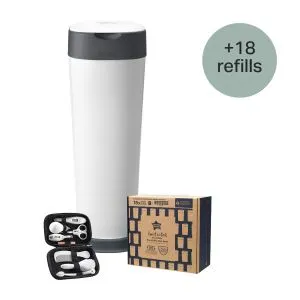
Ultimate XL Nappy Disposal Bundle with 18 Refills
Bundle & Save 40%
Subscription orders can be cancelled at anytime. Free delivery on all subsequent subscription orders. Find out more about subscriptions.
They’re easy and fuss free
Your products are automatically sent to you
You save up to 10% when you sign up for a subscription
You can cancel at any time

If you're bottle feeding with expressed breast milk or formula, you may have come across the term 'paced feeding'.
But what exactly is paced bottle feeding, and how can you do it too? Keep reading for guidance about this baby feeding technique.
Paced bottle feeding simply means letting your baby take the lead when it comes to feeding time. It means they can decide when they're full, rather than requiring them to finish a whole bottle in one go.
It's sometimes referred to as "responsive" or "on demand" feeding, and basically means that you're following your baby's cues.
It involves slowing the flow of milk (expressed breast milk or formula) into the bottle's teat and baby's mouth. This feeding method gives them extra control over the pace of their feed and how much they eat.
Paced feeding mimics the stop-start motion of breastfeeding and gives them the chance to check in on their own appetite.
The benefits of paced feeding include that it:
Getting started with paced feeding requires you to feed based on your little one's early hunger cues, rather than on a set time schedule.
These early hunger cues can include baby:
Explore the Range
While paced feeding, you can switch which side you're holding the bottle and your baby on. This will mimic breastfeeding and keeps your little one stimulated.
Absolutely! This method is designed to be slower and responsive.
Taking a few breaks mid-feed gives you both a chance to enjoy loving eye contact, snuggle and bond. Babies grow so quickly, and before you know it, they'll be ready to begin weaning and moving onto solids. So, paced feeds offer a great opportunity for you to spend some quality one-on-one time together.
Paced feed timings will vary from one baby to the next. In general, they'll last as long as it takes for your baby to decide when they're no longer hungry, usually around 20 minutes.
Does paced feeding help with my baby's development?
Healthline suggests that paced feeding "reduces stomach issues associated with overfeeding or eating too quickly" and "establishes good eating habits from a very young age, which can last a lifetime".
Using a bottle teat with a slower flow that resembles a real life nipple when paced feeding will mimic the flow of breastmilk from the breast, and encourages your baby to suck more.
Our soft silicone teats flex and stretch like mum and allow your baby to feed comfortably at their own natural pace, but when it comes to the actual bottle you use, it's just a case of experimenting with different shapes and sizes to see what suits you!
When your baby is feeding, their lips should rest on the wider part of the bottle's teat. If the milk flow from the bottle you're using seems too fast for your baby, you may need to try a slower flow.
Signs to look out for that indicate the milk flow is too fast include your baby:
If you can, it's a good idea to establish a good breastfeeding routine for six to eight weeks before you introduce your little one to a bottle of expressed breast milk or formula.
Some babies will get straight into the flow of paced bottle feeding, while others will take some time to get used to it. But if you're returning to work or your baby is suffering from colic symptoms, getting them used to paced feeding can really help them transition smoothly from breast to bottle (and back again) when needed.